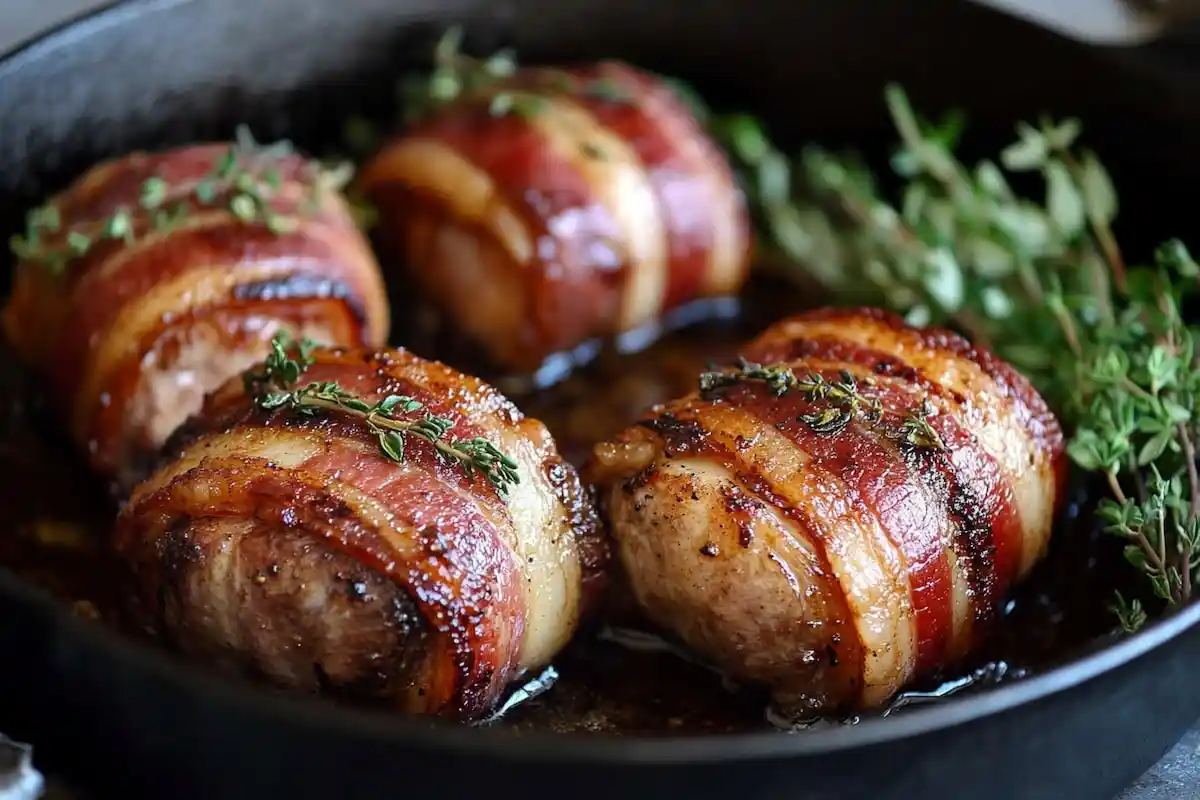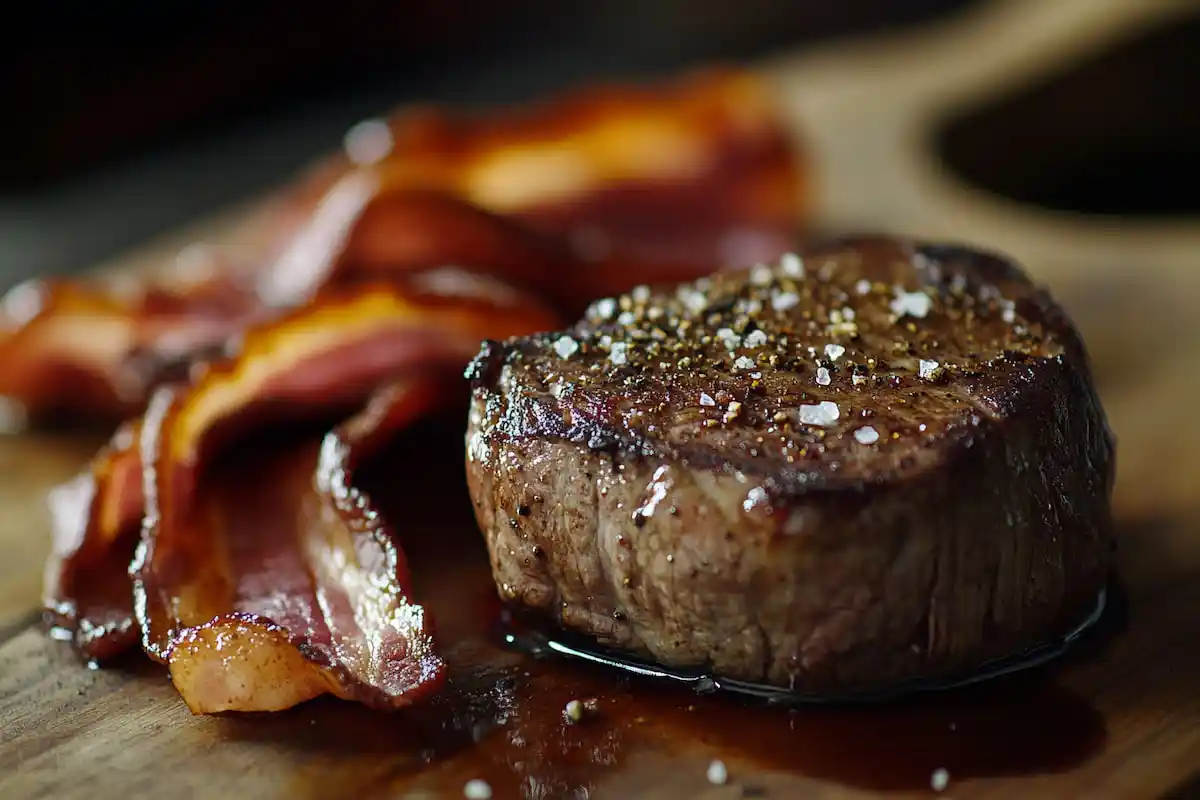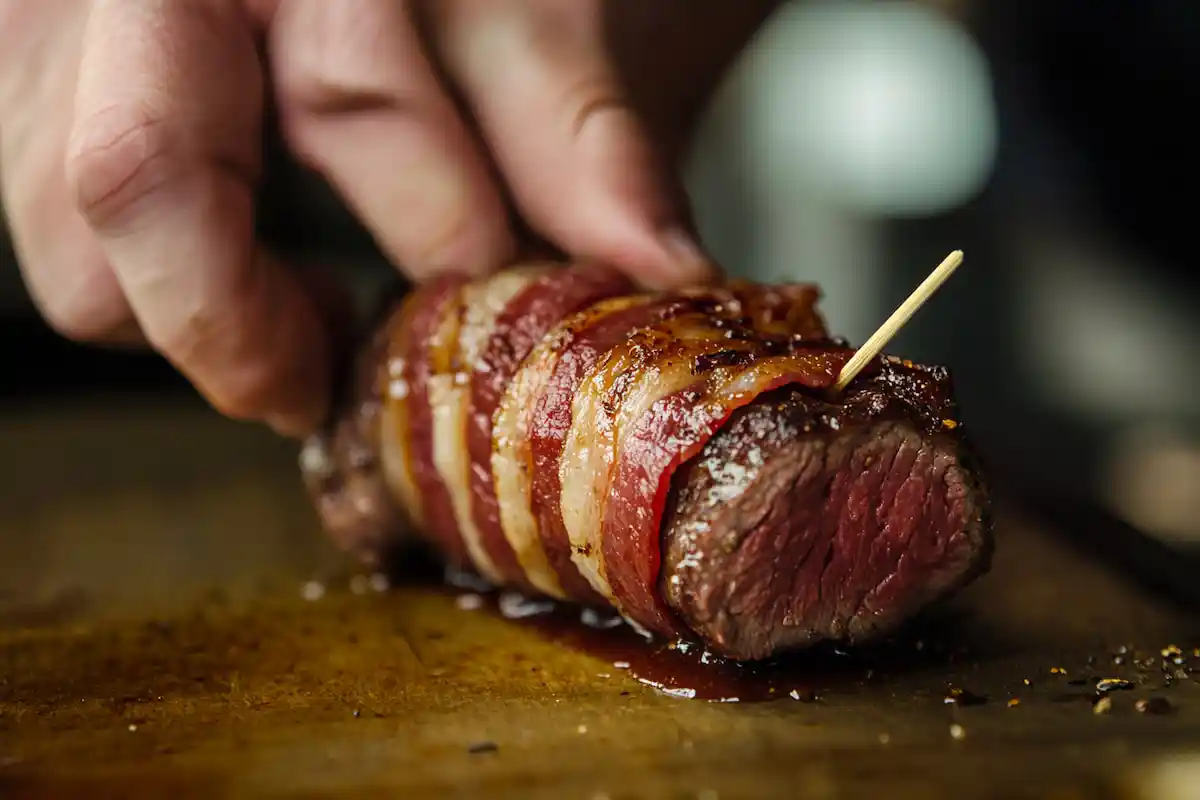Introduction to Bacon-Wrapped Filet Mignon
What is Filet Mignon?
Bacon wrapped filet mignon takes an already luxurious cut of beef to the next level. Known for its tenderness and buttery texture, filet mignon comes from the small end of the tenderloin, prized for its lack of connective tissue. Wrapping it in crispy, flavorful bacon not only enhances its taste but also keeps the steak juicy during cooking.
Often called the “king of steaks,” filet mignon is celebrated for its melt-in-your-mouth texture and rich, subtle beef flavor. Adding bacon provides a savory contrast, elevating this dish to restaurant-quality perfection. Whether for a special occasion or an indulgent treat, bacon-wrapped filet mignon is a showstopper.
What Makes Bacon-Wrapped Filet Mignon Special?
Bacon-wrapped filet mignon is a true indulgence. It combines the luxurious filet mignon with crispy, savory bacon. The magic lies in the balance between the tender filet and the smoky, salty bacon crunch.
The bacon wrapping serves several purposes:
- Flavor infusion: As the bacon cooks, it releases its fats and smoky aroma, which penetrate the beef, enhancing the overall flavor.
- Moisture retention: Bacon adds an additional layer of fat, helping the filet mignon retain its juiciness during cooking.
- Texture contrast: The contrast between the crisp, smoky bacon and the soft, tender filet mignon creates a delightful textural experience.
The result is a visually stunning dish that offers a perfect combination of savory flavors, making it a favorite for steak lovers looking for a new twist on the classic steak dinner.
Why Bacon Complements Filet Mignon
Bacon is the perfect complement to filet mignon because of the rich contrast it provides in both texture and flavor. Filet mignon on its own is incredibly tender but can be subtle in flavor, especially when cooked to a lower doneness. This is where bacon comes in, providing a salty, smoky bite that contrasts beautifully with the delicate, buttery texture of the steak.
Flavor Contrast
- Salty vs. buttery: Bacon is inherently salty, which enhances the natural sweetness and buttery flavor of the filet mignon. This creates a more balanced flavor profile that keeps the taste buds engaged.
- Smoky vs. fresh: The smoky aroma of the bacon complements the mild flavor of the filet, infusing the steak with a depth of flavor without overpowering it.
Texture Contrast
- Crispy bacon vs. tender steak: The crispy, crunchy bacon creates an interesting texture juxtaposed against the melt-in-your-mouth, velvety tenderness of the filet mignon. The contrast in textures adds excitement to each bite, making the dish more dynamic.
Together, these elements make bacon-wrapped filet mignon a show-stopping dish that appeals to all the senses. The combination of smoky, savory bacon with the richness of the tender filet mignon makes each bite an experience to savor.
Flavor Profile and Texture Contrast
The contrast between bacon and filet mignon is extraordinary. As the bacon crisps, it adds a satisfying crunch, followed by the tender, juicy filet. The key is cooking the bacon to crispness without overcooking the filet, which can become dry.
The Sensory Experience:
- First bite: The bacon’s crunch gives way to the soft, buttery filet that melts in your mouth.
- Lingering flavor: The smoky bacon flavor lingers, enhancing the richness of the beef, while the filet’s tenderness provides a satisfying base.
This balance of textures and flavors makes bacon-wrapped filet mignon a luxurious, indulgent dish. It’s not just about taste; it’s a complete sensory experience.
Key Ingredients for Bacon-Wrapped Filet Mignon
Choosing the Right Bacon
When preparing bacon-wrapped filet mignon, the bacon type impacts the flavor and texture. Bacon varies in thickness, flavor, and fat content. Choosing the right bacon can elevate the dish from ordinary to extraordinary.
Key Considerations for Choosing Bacon:
- Thickness: The thickness of the bacon is critical. Thin bacon can become too crispy and may burn before the steak is properly cooked. Thick-cut bacon, on the other hand, provides a meaty texture that holds up better during the cooking process. Thick-cut bacon also retains more moisture, adding extra juiciness to the steak.
- Flavor profile: Consider the flavor profile of your bacon. Regular smoked bacon provides a classic smoky flavor that pairs beautifully with beef. If you prefer something with a hint of sweetness, maple bacon can be an excellent choice. For a bolder, spicier profile, peppered bacon adds a peppery bite that contrasts with the richness of the steak.
- Fat content: Bacon with a higher fat content will render more fat during cooking, keeping the filet mignon moist and juicy. However, too much fat can overpower the flavor of the steak. Finding a balance between lean and fatty bacon is key for achieving the perfect flavor without excess grease.
Bacon Recommendations:
- Thick-Cut Smoked Bacon: Ideal for its balance of flavor and fat, this is the go-to choice for many bacon-wrapped filet mignon recipes.
- Maple Bacon: For those who love a sweet and savory contrast, maple bacon enhances the richness of the filet mignon with a gentle sweetness.
- Peppered Bacon: If you want a little spice with your steak, peppered bacon provides a zesty finish to every bite.
Types of Bacon to Consider
While traditional bacon is a staple, there are several variations that can add unique flavors to your bacon-wrapped filet mignon. Below are some bacon types you might want to explore when preparing your dish.
1. Smoked Bacon
This is the classic choice for wrapping filet mignon. Smoked bacon offers a deep, smoky flavor that pairs perfectly with the mildness of the filet. The flavor intensifies as the bacon crisps, while the smokiness infuses the steak with a savory aroma.
2. Maple Bacon
For a sweet contrast, maple bacon is an excellent choice. The slight sweetness of the maple syrup adds a new layer of flavor, which complements the rich, tender filet mignon. It’s especially good if you’re looking to introduce a subtle sweet and savory element to your dish.
3. Peppered Bacon
Peppered bacon is a bold, flavorful option. The cracked black pepper coating adds a spicy kick, which contrasts wonderfully with the tender, mild filet. This version is perfect for those who like a bit of heat in their dishes.
4. Uncured Bacon
For a more natural taste, uncured bacon is a great option. It contains fewer chemicals, providing a cleaner, more authentic bacon flavor. While it lacks some of the smokiness of cured options, it can offer a different, subtler taste that allows the beef to shine.
5. Turkey Bacon
For a leaner alternative, turkey bacon is a healthier option, though it won’t deliver the same smoky richness as pork bacon. If you’re aiming for a lighter version of bacon-wrapped filet mignon, turkey bacon can still provide a satisfying crunch.
Ideal Filet Mignon Cut
Choosing the right cut of filet mignon is essential to ensure your dish cooks evenly and maintains its tenderness. When selecting filet mignon for wrapping in bacon, consider the following factors:
1. Thickness of the Steak
Filet mignon is known for its tenderness, but the thickness of the cut can affect how it cooks. Ideally, a filet mignon should be at least 1.5 to 2 inches thick to ensure it stays juicy and tender when wrapped in bacon. If the steak is too thin, it may overcook before the bacon has a chance to crisp up.
2. Marbling
Marbling refers to the fat distribution within the steak, and it plays a key role in flavor and tenderness. While filet mignon is naturally lean, a slight amount of marbling will enhance the steak’s juiciness and flavor. Look for cuts that have fine marbling, as this will ensure the steak stays moist during cooking.
3. Freshness and Quality
Always select high-quality, fresh filet mignon from a trusted butcher or grocery store. The fresher the beef, the more flavorful and tender it will be, making your bacon-wrapped filet mignon a memorable meal.
4. Tied vs. Untied
Some filet mignon cuts come pre-tied to help them maintain their shape during cooking. If the cut is untied, you may want to tie it with butcher’s twine to ensure the bacon stays in place and the filet cooks evenly.
How Much Bacon to Use
One of the key challenges in making bacon-wrapped filet mignon is determining how much bacon is needed per steak. Too much bacon can overwhelm the delicate flavor of the filet, while too little may leave the steak lacking in flavor and texture.
General Guidelines for Bacon-Wrapped Filet Mignon:
- One strip of bacon per filet: For a standard 1.5-inch filet, one strip of bacon is generally sufficient. The bacon should wrap around the filet snugly, without overlapping too much. This ensures the bacon crisps properly without overpowering the steak.
- Two strips for thicker steaks: If your filet mignon is thicker, using two strips of bacon may be necessary to ensure a uniform wrap that holds the steak’s moisture and flavor.
- Trim excess bacon: If the bacon is too long, trim the excess to prevent the bacon from curling away from the steak. You want a snug, even wrap.
Ideal Proportions:
The key is balance—enough bacon to complement the steak, but not so much that it takes over the dish. The goal is to enhance the tender filet mignon with the smoky flavor and crispy texture of bacon, without the bacon being the star of the show.
Preparing Bacon-Wrapped Filet Mignon
Step-by-Step Preparation Guide
When preparing bacon-wrapped filet mignon, it’s important to follow a precise method to ensure the steak is perfectly cooked and the bacon crisps to a delicious golden brown. The process involves a few simple steps, but attention to detail is key for achieving the perfect balance of flavors and textures.
1. Prepare the Filet Mignon
Before wrapping the filet mignon in bacon, you’ll want to ensure that it’s properly prepped for cooking. This involves trimming, seasoning, and sometimes marinating the steak. Here’s how:
Trimming the Filet Mignon:
- Filet mignon is often pre-trimmed, but if using a whole tenderloin, remove the silver skin. This tough membrane is inedible and can toughen during cooking. Use a sharp knife to carefully remove it.
- If your filet has a thick fat layer, trim it to about 1/8 inch. This keeps enough fat for flavor while avoiding excess greasiness.
Seasoning the Filet Mignon:
- Basic Seasoning: For filet mignon, you don’t need an elaborate marinade. A simple rub of salt and freshly ground black pepper is enough to enhance the natural flavor of the meat.
- Optional Seasonings: Some chefs prefer to add garlic powder, onion powder, or fresh herbs (like rosemary or thyme) for added depth. A touch of olive oil can also be rubbed onto the steak to help the seasoning adhere and create a nice sear when cooked.
Marinating or Dry Rub:
- Marinades: Marinating the filet mignon before wrapping it in bacon can add flavor, but it’s not necessary for this cut since it’s already so tender. If you choose to marinate, make sure to use an acidic component like red wine, vinegar, or lemon juice to tenderize the meat.
- Dry Rubs: Dry rubs are a great way to introduce additional spices and flavors without compromising the steak’s texture. Consider using a blend of paprika, brown sugar, and herbs for a well-rounded taste.
2. Wrapping the Filet with Bacon
The key to success when wrapping filet mignon with bacon is ensuring that the bacon stays in place during the cooking process while also allowing it to crisp up properly. Here’s how to wrap it:
Method 1: Basic Wrap
- Position the Bacon: Lay the slices of bacon flat on a cutting board, slightly overlapping each piece. If the bacon strips are too long, trim them so they fit around the steak.
- Wrap the Bacon: Starting at one end of the filet, wrap the bacon tightly around the meat, ensuring that the bacon fully covers the steak. The bacon should overlap slightly, but not excessively, to allow for even crisping.
- Securing the Bacon: Use toothpicks or butcher’s twine to secure the bacon in place. If using twine, simply tie it around the steak at both ends and the middle. Toothpicks should be placed in such a way that they don’t pierce the meat too deeply.
Method 2: Lattice Wrap
- Lattice Bacon Wrap: For a more elaborate presentation, you can create a lattice pattern with your bacon. Lay several strips of bacon side by side and weave additional strips over and under to form a crisscross design. Once the lattice is formed, gently place the filet in the center and fold the bacon over it. Secure with toothpicks or twine.
This method results in a crispier bacon exterior, as the bacon has more surface area exposed to heat.
Marinades vs. Dry Rubs
Before wrapping your filet mignon in bacon, you might wonder whether it’s better to marinate the steak or apply a dry rub. Both methods have their merits and can work well, depending on the flavor profile you want to achieve.
Marinades:
- Pros: Marinades help tenderize the meat and infuse it with flavors. If you’re using a marinade with acidic ingredients, the steak will become more flavorful and juicy.
- Cons: Since filet mignon is already so tender, marinating it may not be necessary. Too long in an acidic marinade can break down the meat and make it too soft, so be sure to marinate for no more than 2-4 hours.
Dry Rubs:
- Pros: Dry rubs create a flavorful crust on the outside of the steak. They tend to enhance the natural flavors of the filet without overwhelming them. A dry rub is ideal for those who prefer a more straightforward seasoning approach without altering the steak’s inherent tenderness.
- Cons: A dry rub doesn’t penetrate the meat as deeply as a marinade, so it’s mainly used to enhance the surface flavor.
In general, dry rubs are preferred when preparing bacon-wrapped filet mignon since they allow the bacon to shine while still giving the beef a flavorful, savory exterior.
Cooking Methods for Bacon-Wrapped Filet Mignon
Once you’ve prepped your bacon-wrapped filet mignon, the next crucial step is cooking it to perfection. There are several methods you can use to achieve that mouth-watering balance of crispy bacon and tender filet. Each method brings out different flavors and textures in the steak and bacon. In this section, we’ll explore oven roasting, grilling, and pan-searing techniques, as well as the popular reverse searing method.
Oven Roasting vs. Grilling: Pros and Cons
When it comes to cooking bacon-wrapped filet mignon, two of the most popular methods are oven roasting and grilling. Both offer distinct advantages, but the choice between them depends on your personal preferences, available equipment, and desired flavor profile.
Oven Roasting
Oven roasting is an ideal method for cooking bacon-wrapped filet mignon if you’re looking for a hands-off approach with reliable results. This method ensures that the steak cooks evenly, while also providing a consistent heat source to crisp up the bacon.
Steps for Oven Roasting:
- Preheat your oven to 400°F (200°C).
- Heat a cast-iron skillet or oven-safe pan over medium-high heat. Sear the bacon-wrapped filet mignon for 2-3 minutes on each side to create a golden, crispy crust.
- After searing, transfer the skillet to the oven and roast for about 8-12 minutes, depending on your desired level of doneness. For rare, aim for 120°F (49°C); medium-rare, 130°F (54°C); medium, 140°F (60°C); well-done, 160°F (71°C).
- Once the steak reaches your desired doneness, remove it from the oven and let it rest for 5 minutes before serving.
Pros of Oven Roasting:
- Even Cooking: The steady heat of the oven allows the filet to cook evenly throughout, while the bacon crisps up nicely.
- Low Maintenance: Once the steak is in the oven, you can focus on preparing other parts of your meal, making this method ideal for multitasking.
- Consistent Results: Oven roasting provides consistent results, making it a go-to method for both novice and experienced cooks.
Cons of Oven Roasting:
- Less Smoky Flavor: While the oven gives great results, it doesn’t impart that smoky flavor you get from grilling.
- Bacon Doesn’t Crisp as Much: Although searing before roasting helps, the bacon may not become as crispy as it would on a grill.
Grilling
To Grill bacon-wrapped filet mignon over open flames is a great way to achieve that signature smoky flavor that pairs so well with both the bacon and the steak. Grilling adds a unique char to the meat, enhancing the overall taste and texture of the dish.
Steps for Grilling:
- Preheat your grill to medium-high heat (about 400°F/200°C).
- Place the bacon-wrapped filet mignon directly on the grill. Grill for 5-7 minutes per side, ensuring the bacon crisps up and the steak reaches the desired doneness.
- If using indirect heat, close the lid after searing each side to allow the steak to cook through while maintaining a crispy bacon exterior.
- Once the steak reaches your preferred doneness, remove it from the grill and let it rest for 5 minutes before serving.
Pros of Grilling:
- Smoky Flavor: Grilling imparts a distinct smoky flavor that complements the richness of the filet and the saltiness of the bacon.
- Crispy Bacon: The high, direct heat of the grill crisps the bacon quickly, giving it a satisfying crunch.
- Charred Exterior: The grill can create a beautiful charred crust on the steak, adding depth to the flavor.
Cons of Grilling:
- Risk of Overcooking: The high heat of the grill can sometimes lead to uneven cooking, especially with thicker filets. If not monitored closely, the bacon might burn before the steak is fully cooked.
- Requires More Attention: Unlike oven roasting, grilling requires you to keep a close eye on the steak to prevent burning or undercooking.
Reverse Searing Technique
Reverse searing is a cooking method that’s gaining popularity for its ability to cook a steak evenly and create a crispy, flavorful crust without sacrificing the tenderness of the meat. This method works particularly well for thicker cuts of filet mignon.
Steps for Reverse Searing:
- Preheat your oven to 250°F (120°C).
- Place the bacon-wrapped filet mignon on a wire rack set over a baking sheet. This allows air to circulate around the steak, promoting even cooking.
- Roast the steak in the oven for 20-30 minutes, or until the internal temperature reaches 10-15 degrees below your target temperature (for rare, aim for 110°F/43°C; for medium-rare, 120°F/49°C).
- Heat a cast-iron skillet over high heat and sear the steak for 1-2 minutes per side to develop a crispy, golden-brown crust.
- Let the steak rest for 5 minutes before serving.
Pros of Reverse Searing:
- Even Cooking: The steak cooks slowly in the oven, ensuring that the meat is evenly cooked from edge to edge without overcooking the exterior.
- Perfect Crust: The final sear in the hot skillet results in an incredibly crispy, caramelized crust on both the bacon and the steak.
- Tender and Juicy: Reverse searing preserves the juiciness and tenderness of the filet, making it a foolproof method for perfect doneness.
Cons of Reverse Searing:
- Takes Longer: This method requires more time than traditional searing, making it less suitable if you’re in a hurry.
- Requires Equipment: To use reverse searing, you’ll need both an oven and a skillet, so it’s a bit more involved than the other methods.
Cooking for Rare, Medium, and Well-Done
Achieving the right level of doneness is crucial when preparing filet mignon, especially when wrapped in bacon. The key is to cook the steak to your preferred level while ensuring the bacon crisps up perfectly. Here’s a guide to cooking bacon-wrapped filet mignon for different doneness levels:
Rare (120°F / 49°C)
- The interior of the steak will be cool, with a deep red center. The bacon will be slightly crisp but still tender.
Medium-Rare (130°F / 54°C)
- The steak will have a warm, red center with a juicy, tender texture. The bacon will be crisp around the edges while remaining tender.
Medium (140°F / 60°C)
- The steak will have a pink, warm center and a firmer texture. The bacon will be crispy and well-rendered.
Medium-Well (150°F / 66°C)
- The steak will have a slightly pink center and be firmer. The bacon will be crispy, and there will be less moisture in the meat.
Well-Done (160°F / 71°C)
- The steak will be cooked through with little to no pinkness. The bacon will be very crispy, but there may be a slight risk of dryness in the meat.
Tip: Always use a meat thermometer to check the internal temperature of your filet mignon. This ensures you cook it to the exact level of doneness that you prefer without guessing.
Managing Bacon Grease
One challenge when cooking bacon-wrapped filet mignon is managing the bacon grease. As the bacon renders, it releases fat that can pool around the steak, potentially making the dish greasy. Here are some tips for managing bacon grease:
- Sear the Steak First: Searing the bacon-wrapped filet mignon in a hot pan before roasting or grilling helps render some of the fat and crisp the bacon. It also reduces the amount of grease that pools during cooking.
- Use a Rack: When oven-roasting, use a wire rack to elevate the steak, allowing the excess bacon grease to drip off, preventing it from soaking into the meat.
- Monitor the Grill: If grilling, be sure to check for excess grease that may cause flare-ups, which could burn the bacon. Clean your grill grates beforehand to avoid excessive grease buildup.



